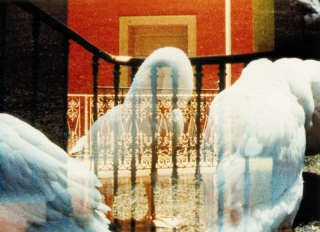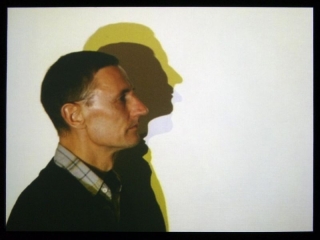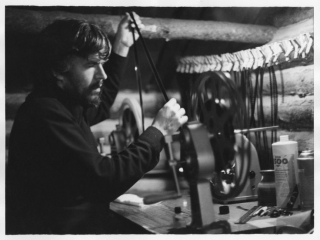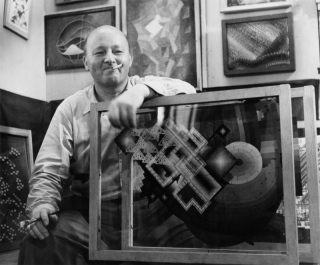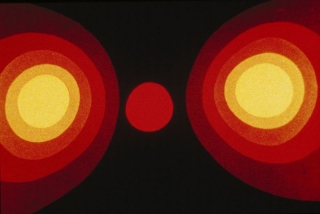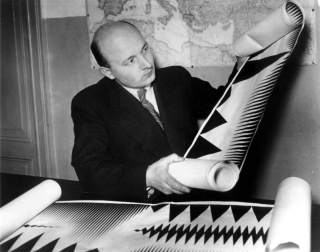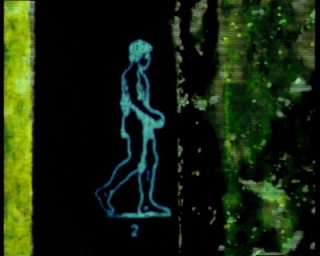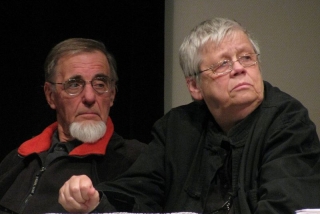Date: 12 November 2003 | Season: LUX Salon
LUX SALON: HANNES SCHÜPBACH: FILM SOLO
Wednesday 12 November 2003, at 7:30pm
London LUX
The Swiss artist Hannes Schüpbach creates silent colour films that evoke an experience similar to poetry. He composes and varies images of places, people, and gestures, deriving from a specific living context in each film. The subtlety and distance of his images invite the eye to ‘listen’ very carefully. The program shows the gradual development of the artist’s film language, based on the nature of the film image as both trace of reality and potential metaphor. Hannes Schüpbach has been working with film, parallel to his large painting suites, since the early 1990s.
Hannes Schüpbach, Portrait Mariage, 2000, colour, silent, 9 min
Hannes Schüpbach, Spin, 2001, colour, silent, 12 min
Hannes Schüpbach, Toccata, 2002, colour, silent, 28 min
PROGRAMME NOTES
LUX SALON: HANNES SCHÜPBACH: FILM SOLO
Wednesday 12 November 2003, at 7:30pm
London LUX
PORTRAIT MARIAGE (filmed in the Val Bregaglia, Switzerland)
Hannes Schüpbach, Switzerland, 2000, colour, silent 9 min
Portrait Mariage turns the staging of a rite of passage into an allusively layered narrative. The film distils a sensual remembrance by the filmmaker’s intense participation and his spontaneous aesthetic choices.
SPIN (filmed in Winterthur, Switzerland)
Hannes Schüpbach, Switzerland, 2001, colour, silent, 12 min
Spin reflects the beauty of the transitory and evokes the regret connect to its passing. The artist’s ageing mother, at the centre of this film, marks the unique presence of the single human consciousness. (Spin – the inherent turning momentum of electrons.)
TOCCATA (filmed in Genoa, Italy, 1999-2001)
Hannes Schüpbach, Switzerland, 2002, colour, silent, 28 min
Toccata develops the ‘touch of the place’ through a direct encounter with the seemingly familiar elements of a house and city. The image recreates an inner experience by the use of a wide range of stylised movements and colourings. “Il tocco means not only touch; it can also mean a small quantity, a single brush stroke in painting, the striking of a bell or piano keys.” Toccata was screened at the 2002 New York Film Festival’s ‘Views from the Avant-Garde’.
Back to top
Date: 14 November 2003 | Season: LUX Salon
LUX SALON: WERNER VON MUTZENBECHER: EVERYDAY ACTIONS / ORDINARY OBJECTS
Friday 14 November 2003, at 7:30pm
London LUX
The first ever UK solo screening for this established Swiss artist, who will present a selection of his films from 1971 to present. Mutzenbecher began painting in 1958 and filmmaking in 1968, and has exhibited regularly in Switzerland and Europe. Apparently mundane actions and objects are the focus of his films, which blur the boundaries between materiality, portraiture and performance. The early works are more performative, while later films take a diaristic, personal approach to create impressions of Mutzenbecher’s immediate environment, using those characteristics unique to the medium.
Werner Von Mutzenbecher, III/71, 1971, b/w, sound, 15 min
Werner Von Mutzenbecher, XIV/82 Filme, 1982, colour, sound, 21 min
Werner Von Mutzenbecher, XV/84 Vogelhaus, 1984, b/w, sound, 9 min
Werner Von Mutzenbecher, XVI/84 Fenster III, 1984, b/w, silent, 4 min
Werner Von Mutzenbecher, XVIII/85 Untergrund, 1985, b/w, sound, 5 min
Werner Von Mutzenbecher, XIX/88 4 mal 8, 1988, colour, silent, 3 min
Werner Von Mutzenbecher, XXIV/99 Fenster IV, 1999, colour, sound, 3 min
Werner Von Mutzenbecher, XXVI/99/03 Rencontres, 1999/2003, b/w, silent, 2 min
Werner Von Mutzenbecher, XXVII/03 Filmmakers’ Afternoon, 2003, b/w, silent, 6 min
PROGRAMME NOTES
LUX SALON: WERNER VON MUTZENBECHER: EVERYDAY ACTIONS / ORDINARY OBJECTS
Friday 14 November 2003, at 7:30pm
London LUX
FILMMAKERS CREDO (Werner Von Mutzenbecher, 2003)
film is a motion-picture
film is emotion
film is approachable to everybody
film is a language with laws to respect
experimental film can be compared to music, to poetry
film-pictures reach the consciousness and the subconscious
film is psychology
film is the most complex medium: time, movement and space are connected
film is memory
film is a document of time, places and persons
film is rhythm, is speed, but can also be slow and quiet
film is animation
film occupies the eyes, feeds the fantasy
film can be more real than reality
film is between reality and dream
film can manipulate the truth, film can be dangerous
film can be realised almost alone like a painting
imagination and innovation can be forced by a low budget
film-pictures can transport ideas and sentiments without words
silence can be like a sound
sound can influence the character of the images, can change the atmosphere
self-made film-pictures can be perceived as found footage
filmmaker, camera and projection make a fruitful triangle together
film open doors
film let feel the relativity of positions
film produces film
film constructs a new reality
film-projection is a moving painting of lights and shadows
film is an illusion
film is fugitive like life-time
film is a travel in space and time
film is a constant metamorphosis of images taken from reality
film explore the secrets of visible an invisible things
film is a mystery
About ten years after the beginning of my painting career I realised my first film and I also began to write. Since these days, I continue painting, filmmaking and writing with more or less intensity. To be able to speak different languages opened to me a larger spectrum of expression. I like the complexity and the possibilities inside the film and I am still curious to see what I can do by myself with a camera.
Back to top
Date: 15 November 2003 | Season: Miscellaneous | Tags: Stan Brakhage
A SNAIL’S TRAIL IN THE MTRIBUTE TO STAN BRAKHAGE
Saturday 15 November 2003, at 2:45pm
Bristol Watershed
A LUX event for Brief Encounters
“Imagine an eye unruled by man-made laws of perspective, an eye unprejudiced by compositional logic, an eye which does not respond to the name of everything but which must know each object encountered in life through an adventure in perception.” —Stan Brakhage, Metaphors on Vision, 1963
Widely regarded as the most original and influential independent filmmaker of his generation, Stan Brakhage was not only a consummate artist, but also a great teacher, a passionate champion of the work of others and a huge fan of mainstream movies. His death in March 2003 brought to an end an abundant flow of imagery that produced over 300 films in five decades. His films were a search for a purity of vision unhindered by conventions of seeing. This fleeting survey of his work, including both photographed and hand-painted films, begins with a portrait of the artist made for French television earlier this year.
The curator of this event, Mark Webber will introduce this screening. Mark Webber is an independent programmer of avant-garde film and video, and is Project Manager at LUX.
Pip Chodorov, A Visit to Stan Brakhage, France, 2003, 15 min
This short documentary, commissioned by ARTE and shot in January 2003, provides an invaluable introduction to Brakhage’s work and personality.
Stan Brakhage, Autumnal, US, 1993, 5 min
In the 1990s, Brakhage concentrated mainly on hand-crafted films, usually painting directly on the filmstrip to manifest his ‘hypnagogic vision’.
Stan Brakhage, Reflections on Black, US, 1955, 12 min
During the post-war period of avant-garde psychodrama, Brakhage developed a singular approach. Reflections on Black is the most complex of his early trance films and one of his few works with sound.
Stan Brakhage, Mothlight, US, 1963, 4 min
Moth wings and vegetation were placed between strips of clear plastic to create a sculptural film without a camera. “What a moth might see from birth to death if black were white and white were black.”
Stan Brakhage, Murder Psalm, US, 1981, 17 min
Uncharacteristically for Brakhage this film is composed mostly of found-footage, which is assembled as comment on the monstrous nature of humanity.
Stan Brakhage, Ephemeral Solidity, US, 1993, 5 min
“One of the most elaborately edited of all the hand-painted films – a Haydnesque complexity of thematic variations on a totally visual (i.e. un-musical) theme.”
Stan Brakhage, Creation, US, 1979, 16 min
A journey to Alaska inspired this allegorical vision of the formation of the Earth and the emergence of life.
Stan Brakhage, Chinese Series, US, 2003, 2 min
Made by scratching with his fingernails into black 35mm film, using spit to soften the emulsion. He continued to work on this film until his death, and gave instruction that it was then to be considered complete.
Date: 5 December 2003 | Season: Oskar Fischinger
OSKAR FISCHINGER: MUSIC AND MOTION
5—9 December 2003
London Goethe-Institut
A TRIBUTE TO THE PIONEER OF ANIMATION, ABSTRACT CINEMA & VISUAL MUSIC
“Decades before computer graphics, before music videos, even before Fantasia, there were the abstract animated films of Oskar Fischinger (1900-1967). He was cinema’s Kandinsky, an animator who, beginning in the 1920s in Germany, created exquisite ‘visual music’ using geometric patterns and shapes choreographed tightly to classical music and jazz.” (John Canemaker, New York Times)
Oskar Fischinger is one of the masters of animated film and an influential pioneer of abstract cinema. Though fiercely independent and resolute, Fischinger spent periods under contract to major studios including Paramount, MGM, and Orson Welles’ Mercury Productions. During his brief tenure at Disney, he had some early involvement with Fantasia, which diluted, but popularised, many of his theories about the confluence of music and visual movement.
Born in Gelnhausen, near Frankfurt, in 1900, Fischinger trained as an engineer and, becoming interested in the newly emerging avant-garde cinema, invented a wax-slicing animation machine for creating and photographing abstract imagery. Moving to Munich and later Berlin in the 1920s, he began to make his own experimental films, participated in ‘light shows’ with composer Alexander László and did special effects for Fritz Lang’s Frau im Mond. His early, hand-drawn Studies, in which abstract or graphic shapes oscillate and transform, closely synchronised to gramophone records, were among the first examples of ‘absolute cinema’. The 1930s were successful years with public and artistic acclaim, frequent screenings and advertising commissions, leading to an invitation to Hollywood from Paramount Studios. Working with photography, silhouettes, liquids, oil painting, models and charcoal drawings, Fischinger achieved a synthesis of sound and vision, anticipating what later became the music video.
During his years in America, his unique and colourful ‘visual music’ developed through more complex techniques and innovations, and Oskar received the recognition of his peers and support from the Solomon R. Guggenheim Foundation. In later years he turned to painting as film became more expensive and problematic to produce. Fischinger died of a heart attack in Los Angeles, 1967, after which his artistic legacy was secured and promoted by the tireless work of his devoted widow Elfriede and scholar Dr. William Moritz, whose definitive biography of Oskar will be launched at this event.
Special Event – Book launch “Optical Poetry: The Life and Work of Oskar Fischinger”
Saturday 6 December 2003, at 6pm
Free drinks reception courtesy of John Libbey Publishers to celebrate the publication of Dr William Moritz’ long awaited, definitive biography of Oskar Fischinger. This book, and video tapes of Fischinger’s work released by Re:Voir, will be available for sale over the weekend.
The two programmes of films by Oskar Fischinger will also be screened at Dundee Contemporary Arts and Glasgow Film Theatre.
Please Note: This programme now travels under the title “Optical Poetry: Oskar Fischinger Retrospective” and is distributed by the Center for Visual Music.
Photograph of Oskar Fischinger © Center for Visual Music, all rights reserved.
Date: 5 December 2003 | Season: Oskar Fischinger
OSKAR FISCHINGER: THE MASTERWORKS
Friday 5 December 2003, at 7pm
London Goethe-Institut
A selection of Fischinger’s best-known works made between 1927-47, presented in their original formats with new prints restored by Academy Film Archive. This programme includes the early black & white Studies, Composition in Blue, Allegretto, Radio Dynamics, Motion Painting No. 1 and his other finest films.
Oskar Fischinger, R-1 (Ein Formspiel), 1927, 35mm, b/w & colour, silent with separate soundtrack, 7 min (Reconstruction by William Moritz)
Oskar Fischinger, Study No. 1, 1927, 35mm, b/w, silent, 2 min
Oskar Fischinger, Study No. 2, 1930, 35mm, b/w, silent, 2 min
Oskar Fischinger, Liebesspiel, 1931, 35mm, b/w, silent, 2 min
Oskar Fischinger, Study No. 6, 1930, 35mm, b/w, sound, 2 min
Oskar Fischinger, Study No. 9, 1931, 35mm, b/w, sound, 5 min
Oskar Fischinger, Study No. 11A, 1934, 35mm, colour, sound, 3 min
Oskar Fischinger, Kreise (Abstract Version), 1933-34, 35mm, colour, sound, 2 min
Oskar Fischinger, Composition in Blue, 1935, 35mm, colour, sound, 4 min
Oskar Fischinger, Allegretto (Early Version), 1936-43, 35mm, colour, sound, 3 min
Oskar Fischinger, Paragretto, 1936, 35mm, b/w, sound, 3 min
Oskar Fischinger, Allegretto (Late Version), 1943, 35mm, colour, sound, 3 min
Oskar Fischinger, An Optical Poem, 1937, 35mm, colour, sound, 7 min
Oskar Fischinger, An American March, 1941, 35mm, colour, sound, 3 min
Oskar Fischinger, Radio Dynamics, 1942, 35mm, colour, silent, 4 min
Oskar Fischinger, Motion Painting No. 1, 1947, 35mm, colour, sound, 11 min
Oskar Fischinger films provided thanks to The Fischinger Archive, Centre for Visual Music, and The Academy Film Archive.
Screening repeats Monday 8 December at 7pm. The screening on Friday evening will be introduced by A.L. Rees, Senior Research Fellow, Royal College of Art.
This programme will also be shown at Dundee Contemporary Arts on Friday 12 December 2003, and Glasgow Film Theatre on Monday 15 December 2003.
Please Note: This programme now travels under the title “Optical Poetry: Oskar Fischinger Retrospective” and is distributed by the Center for Visual Music.
Film still from Radio Dynamics (Oskar Fischinger, 1942) © Center for Visual Music, all rights reserved.
Date: 6 December 2003 | Season: Oskar Fischinger
THE FISCHINGER EFFECT
Saturday 6 December 2003, at 4pm
London Goethe-Institut
A selection of works by international artists who have been inspired by Fischinger’s works. Including both classics and rare works by Jordan Belson, Larry Cuba, Jim Davis, Jules Engel, Hy Hirsh, Len Lye, Norman McLaren, José Antonio Sistiaga, Alexandre Vitkine and John Whitney.
Norman McLaren, Stars and Stripes, 1939, 16mm, colour, sound, 3 min
Bart Vegter, Four Moves, 1987, 16mm, colour, sound, 7 min
Jules Engel, Rumble, 1975, 16mm, b/w, sound, 3 min
Len Lye, Particles in Space, 1979, 16mm, b/w, sound, 4 min
John Whitney, Celery Stalks at Midnight, 1952, 16mm, colour, sound, 3 min
Jim Davis, Impulses, 1958, 16mm, colour, sound, 10 min
Leif Marcussen, Tonespor, 1983, 16mm, colour, sound, 8 min
Alexandre Vitkine, Chromophonie, 1967, 16mm, colour, sound, 7 min
Jordan Belson, Allures, 1961, 16mm, colour, sound, 7 min
Larry Cuba, Two Space, 1979, 16mm, b/w, sound, 8 min
Hy Hirsh, Come Closer, 1952, 16mm, colour, sound, 7 min
José Antonio Sistiaga, Paysage Inquiétant – Nocture, 1991, 16mm, colour, sound, 14 min
This screening is dedicated to the memory of Jules Engel (1909-2003).
Date: 6 December 2003 | Season: Oskar Fischinger
OSKAR FISCHINGER: RARITIES, LATE FRAGMENTS & ADVERTISING FILMS
Saturday 6 December 2003, at 7pm
London Goethe-Institut
A unique selection of rare films and unfinished experiments, including München-Berlin Wanderung, Spiritual Constructions and Swiss Trip (Rivers and Landscapes). There is also an opportunity to view nine of Fischinger’s advertising films including the legendary Muratti cigarette commercials.
Oskar Fischinger, Study No. 7, 1931, 16mm, b/w, sound, 3 min
Oskar Fischinger, Wax Experiments, 1923, 16mm, tinted b/w, silent, 8 min
Oskar Fischinger, Spiritual Constructions, 1927, 16mm, b/w, sound, 7 min
Oskar Fischinger, Spirals, 1926, 35mm, b/w, silent, 4 min
Oskar Fischinger, München-Berlin Wanderung, 1927, 35mm, b/w, silent, 3 min
Oskar Fischinger, Ornament Sound, 1932, 35mm, b/w, sound, 4 min
Oskar Fischinger, Study No. 8, 1931, 35mm, b/w, sound, 5 min
Oskar Fischinger, Squares, 1934, 35mm, colour, silent, 4 min
Oskar Fischinger, Coriolan Fragment (Unfinished Study No. 13), 1933-34, 35mm, b/w, silent, 1 min
Oskar Fischinger, Coloratura, 1932, 35mm, b/w, sound, 3 min
Oskar Fischinger, Kreise (Tolirag version), 1933-34, 35mm, colour, sound, 2 min
Oskar Fischinger, Muratti Privat, 1935, 35mm, b/w, sound, 3 min
Oskar Fischinger, Borg (Fiesta fragment), 1934, 35mm, b/w, sound, 1 min
Oskar Fischinger, Muntz T.V., 1952, 35mm, b/w, sound, 1 min
Oskar Fischinger, Muratti Grieft Ein, 1934, 16mm, b/w, sound, 3 min
Oskar Fischinger, Oklahomas Gas, 1952, 16mm, b/w, sound, 1 min
Oskar Fischinger, Northern Tissue, 1948, 16mm, b/w, sound, 1 min
Oskar Fischinger, Organic Fragment, 1941, 16mm, colour, silent, 1 min
Oskar Fischinger, Mutoscope Reels, c.1945, 16mm, colour, silent, 2 min
Oskar Fischinger, Motion Painting (fragments), 1950s, 16mm, colour, silent, 4 min
Oskar Fischinger, Motion Painting No. 2 (fragments), c.1960, 35mm, colour, silent, 2 min
Oskar Fischinger, Swiss Trip (Rivers and Landscapes), 1934, 35mm, colour, sound, 13 min
Oskar Fischinger films provided thanks to The Fischinger Archive, Centre for Visual Music, and The Academy Film Archive.
Screening repeats Tuesday 9 December at 7pm. The screening on Saturday evening will be introduced by Monika Koencke, PhD Research Student, Edinburgh University.
This programme will also be shown at Dundee Contemporary Arts on Sunday 14 December 2003, and Glasgow Film Theatre on Wednesday 17 December 2003.
Please Note: This programme now travels under the title “Optical Poetry: Oskar Fischinger Retrospective” and is distributed by the Center for Visual Music.
Photograph of Oskar Fischinger © Center for Visual Music, all rights reserved.
Date: 14 January 2004 | Season: LUX Salon
LUX SALON: DIRK DE BRUYN: ANCIENT DAMAGE
Wednesday 14 January 2004, at 7:30pm
London LUX
Born in the Netherlands, Dirk de Bruyn has been active as an artist, writer and organiser for over 30 years, primarily in Australia where he has been a central figure in the Melbourne film scene. De Bruyn uses a variety of techniques including direct animation, flicker, time lapse and hand-processing to create dynamic personal cinema. This programme features a film from each decade and includes the world premiere of Analog Stress.
Dirk de Bruyn, Running, 1976, colour, sound, 30 min
Dirk de Bruyn, Boerdery, 1985, colour, sound, 11 min
Dirk de Bruyn, Rote Movie, 1994, colour, sound, 12 min
Dirk de Bruyn, Analog Stress, 2004, colour, sound, 12 min
PROGRAMME NOTES
LUX SALON: DIRK DE BRUYN: ANCIENT DAMAGE
Wednesday 14 January 2004, at 7:30pm
London LUX
RUNNING
Dirk de Bruyn, 1976, 16mm, colour, sound, 30 min
The reworking repetition and reprocessing of a strip of film of two people walking down a lane. The flashing positive and negative images force the viewer to stare rather than looking at the film. Made at a time when the filmmaker had access to a professional processing machine and chemicals.
BOERDERY
Dirk de Bruyn, 1985, 16mm, colour, sound, 11 min
A time-lapse document of a farmhouse in the Netherlands mapping the changing seasons, the light and shadows. Made with an interval-meter fashioned out of a wind screen wiper motor. Music by Chris Knowles
ROTE MOVIE
Dirk de Bruyn, 1994, 16mm, colour, sound, 12 min
“On the voice over de Bruyn places himself behind the wheel of a car, an appropriate metaphor for his expatriate driven reflections on his feelings of exile, distance and loneliness. Necessarily unintelligent memories highlight habitual subjectivity of “walking through a landscape alone”, “gypsy”, “victim”. Images of road signs, cars, billboards, the passing landscape; elegantly simple rotoscope (by rote?) drawings, recopied and texturally manipulated filmic images; the inevitability of the repetition of leader. A tired, yearning, moving film.” —Steven Ball, Mesh 3, Autumn 1994
ANALOG STRESS
Dirk de Bruyn, 2004, 16mm, colour, sound, 12 min
Made from reworked and reanimated found industrial and discarded personal footage. The main focus is the soundtrack which has been reconstructed from scratches, pen marks, Letraset strips and the music and phrases of found films.
Back to top
Date: 3 February 2004 | Season: LUX Salon
LUX SALON: BJØRN MELHUS
Tuesday 3 Februry 2004, at 7:30pm
London LUX
Bjørn Melhus is a media artist who reprocesses recognisable elements of American culture, feature films and daytime television into a humorous, but unsettling, reflection of modern life. From his 16mm student films and early videotapes, through to his more recent, technically seamless, digital productions, Melhus has continued to explore the boundaries between the real world and its fictional counterpart. Further blurring our perception, he performs as every character in each, building a dizzying repertory of doppelgangers.
Bjørn Melhus, Das Zauberglas, 1991, colour, sound, 6 min
Bjørn Melhus, No Sunshine, 1997, colour, sound, 6 min
Bjørn Melhus, The Oral Thing, 2001, colour, sound, 8 min
Bjørn Melhus, Auto Center Drive, 2003, colour, sound, 28 min
Bjørn Melhus, Cornflakes, 1987, colour, sound, 2 min
The screening will begin with documentation of Bjørn Melhus’ installation Primetime (2001).
PROGRAMME NOTES
LUX SALON: BJØRN MELHUS
Tuesday 3 Februry 2004, at 7:30pm
London LUX
DAS ZAUBERGLAS (THE MAGIC GLASS)
Bjørn Melhus, 1991, colour, sound, 6 min
“Like Faust in the witch’s kitchen scene, who sees a heavenly image in a magic mirror and recognises the model of all women who awaken his longing, the man in Das Zauberglas also experiences longing and joy when he encounters his female alter ego in the 20th century’s magic mirror – the television screen. But here the joy is not enduring, and is ultimately foiled by the parameters of a media world” —Barbara Nierhoff
NO SUNSHINE
Bjørn Melhus, 1997, colour, sound, 6 min
“The basis of all my work is a previously composed sound and speech collage, often set to a rhythm, and certainly quotes fragments of an already present pop culture. They are nevertheless not pop music at all. They do not bear any musical product or any sort of lifestyle ideology, and shouldn’t either, although they certainly confront this.” —Bjørn Melhus
THE ORAL THING
Bjørn Melhus, 2001, colour, sound, 8 min
“In The Oral Thing, Melhus plays a cast of weird characters in a disturbing spiritual self-help parody using game and talk show sound bytes. The ‘host’ offers redemption, while the ‘guests’ confess terrible secrets in front of an ‘audience’ of hooded clones.” —William Powhida
AUTO CENTER DRIVE
Bjørn Melhus, 2003, colour, sound, 28 min
“The film plays at different levels. In addition to a very personal, metaphoric narration, it deals with the construction and deconstruction of the ego. In Western culture the ego is an invention based on media projections, just as the suburban surroundings seem to increasingle follow a script” —International Kurzfilmage Oberhausen
CORNFLAKES
Bjørn Melhus, Cornflakes, 1987, colour, sound, 2 min
An early 16mm film on the subject of consumption and commercials. Made at the Braunschweig School of Arts, shown tonight just for fun.
Bjørn Melhus’ first British solo show “Primetime” is at FACT Liverpool until 7 March 2004.
This LUX Salon is presented in association with the Serpentine Gallery to coincide with their current exhibition “State of Play” (3 February – 28 March 2004). The exhibition presents the work of international artists who play with ideas and situations. At a time when art can no longer be defined through a single dominant movement or school of thought, the exhibition identifies a number of artists who share an attitude of irreverence and wit, and a lightness of touch increasingly visible in contemporary art making today. Featuring Maurizio Cattelan, Martin Creed, Tony Feher, Bjørn Melhus, Aleksandra Mir, Tim Noble and Sue Webster, Pipilotti Rist, David Shrigley, Andreas Slominski and Sarah Sze. Curated by Rochelle Steiner.
Back to top
Date: 5 March 2004 | Season: Vasulka Video
VASULKA VIDEO: PIONEERS OF ELECTRONIC ART
5—7 March 2004
London Candid Arts Trust & University of Westminster
Steina and Woody Vasulka began to use the medium of video as early as 1969, first documenting jazz performances, rock concerts and the underground activities of ‘illegitimate culture’. Exploiting the relationship between the electronic signals for both sound and image, they started a didactic exploration of the limitless possibilities of video processing using a range of newly crafted technological tools. Each tape produced was a by-product of the dialogue between the Vasulkas and their machines, as they systematically analysed and deconstructed the fundamental materiality of video through spatial, temporal and sound/image manipulation. The Vasulkas are the creative pathfinders of the electro-magnetic spectrum, whose works – infused with the fizz and crunch of the analogue age – are as mesmerising and astounding today as in their original moment of discovery.
Steina and Woody Vasulka will present three unique events during the weekend, which includes a continuous one-day gallery projection of key works.
STEINA & WOODY VASULKA: PIONEERS OF ELECTRONIC ART
VASULKA VIDEO: PIONEERS OF ELECTRONIC ART
5—7 March 2004
London Candid Arts Trust & University of Westminster
Since 1969, when they had their first access to primitive video equipment, the Vasulkas have conducted a dynamic exploration of the electro-magnetic image. Woody was born in Czechoslovakia in 1937 and trained as an engineer and filmmaker, Steina was born in Iceland in 1940 and became a professional musician. They married in 1964 and immigrated to America the following year. After seeing the ground-breaking TV as a Creative Medium exhibition at the Howard Wise Gallery in 1969, they devoted their activity to video, first documenting New York cultural events including jazz and rock concerts and underground performances using a Sony Portapak camera. Soon after, they began to experiment with using VCS3 and Buchla audio synthesisers to alter the electronic video signal, making their first image-processed tapes.
In 1971, together with Andy Mannick, the Vasulkas co-founded The Electronic Kitchen, an electronic laboratory for experimentation with sounds and images. The Kitchen soon became one of the artistic centres of New York, presenting screenings, performances and concerts ranging from the new music of La Monte Young to the new wave of Talking Heads, and it continues today as one of the city’s most prestigious multi-media art spaces.
Throughout the 1970s, the Vasulkas continued their tireless investigations into the phenomenology of video, with each tape produced being effectively a by-product of the dialogue between them and their machines. Steina and Woody did not create their images from video synthesisers; their unique approach involved the processing of previously recorded material through a series of modular units, frequently using the input of a separate electronic signal to control the effects.
Working in collaboration with creative engineers including George Brown, Bill Etra and Eric Siegel, they developed a new range of tools and devices with which they can further investigate the image. Their arsenal of analogue equipment contains the Rutt/Etra Scan Processor, Dual Colorizer, Multikeyer, Programmer, Horizontal Drift Variable Clock and the Field Flip/Flop Switcher. Much of their work explores and exploits the similarity of the sound and image signals, producing a mesmerising range of synaesthetic video before the onset of the digital age.
In 1973, the Vasulkas moved to Buffalo to teach at the Media/Study Center, where they become part of a faculty including filmmakers and theorists Tony Conrad, Hollis Frampton and Paul Sharits. The pair also began to work individually during this time. Steina embarked on the Machine Vision series, developing mechanical systems to control the camera, distancing it from the human viewpoint. Woody began to explore the digital realm, custom-designing the Digital Image Articulator. Both subsequently worked on interactive projects and large-scale installations, adding a sculptural or monumental element to their practice.
As pioneers of video art, Steina and Woody Vasulka stand alongside Nam June Paik, Peter Campus and Joan Jonas, with the Kitchen and their own studio as much a point of focus as the early activist groups Video Free America, Raindance and Guerilla Television and the innovative American television laboratories of NCET, WNET and WGBH. This weekend of events is the first opportunity in decades to see a substantial collection of the Vasulka’s early works in the UK, and a rare chance to hear the exuberant and vivacious duo discuss their work from a practical, rather than theoretical, point of view.
Back to top
